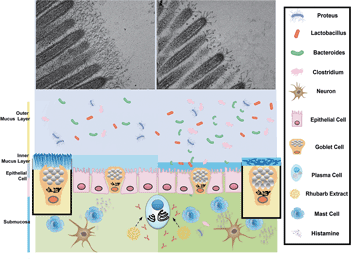Article contents
An Unexpected Alteration Colonic Mucus Appearance in the Constipation Model via an Intestinal Microenvironment
Published online by Cambridge University Press: 30 May 2022
Abstract

Due to the lack of research between the inner layers in the structure of colonic mucous and the metabolism of fatty acid in the constipation model, we aim to determine the changes in the mucous phenotype of the colonic glycocalyx and the microbial community structure following treatment with Rhubarb extract in our research. The constipation and treatment models are generated using adult male C57BL/6N mice. We perform light microscopy and transmission electron microscopy (TEM) to detect a Muc2-rich inner mucus layer attached to mice colon under different conditions. In addition, 16S rDNA sequencing is performed to examine the intestinal flora. According to TEM images, we demonstrate that Rhubarb can promote mucin secretion and find direct evidence of dendritic structure-linked mucus structures with its assembly into a lamellar network in a pore size distribution in the isolated colon section. Moreover, the diversity of intestinal flora has noticeable changes in constipated mice. The present study characterizes a dendritic structure and persistent cross-links have significant changes accompanied by the alteration of intestinal flora in feces in models of constipation and pretreatment with Rhubarb extract.
- Type
- Biological Applications
- Information
- Copyright
- Copyright © The Author(s), 2022. Published by Cambridge University Press on behalf of the Microscopy Society of America
Footnotes
These authors have contributed equally to this work and share the first authorship.
References
- 2
- Cited by




